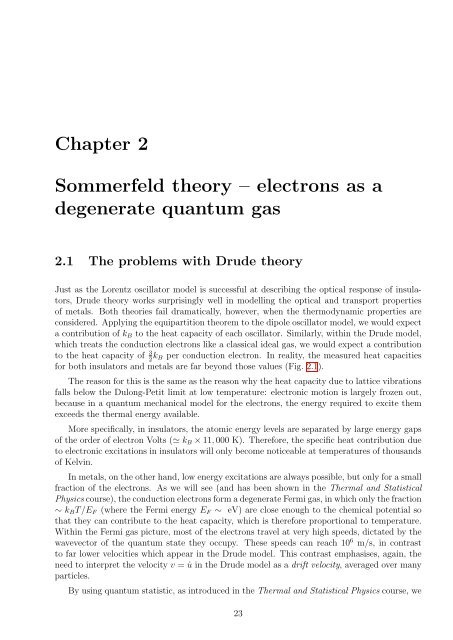Set of supplementary notes.
Set of supplementary notes.
Set of supplementary notes.
Create successful ePaper yourself
Turn your PDF publications into a flip-book with our unique Google optimized e-Paper software.
Chapter 2<br />
Sommerfeld theory – electrons as a<br />
degenerate quantum gas<br />
2.1 The problems with Drude theory<br />
Just as the Lorentz oscillator model is successful at describing the optical response <strong>of</strong> insulators,<br />
Drude theory works surprisingly well in modelling the optical and transport properties<br />
<strong>of</strong> metals. Both theories fail dramatically, however, when the thermodynamic properties are<br />
considered. Applying the equipartition theorem to the dipole oscillator model, we would expect<br />
a contribution <strong>of</strong> k B to the heat capacity <strong>of</strong> each oscillator. Similarly, within the Drude model,<br />
which treats the conduction electrons like a classical ideal gas, we would expect a contribution<br />
to the heat capacity <strong>of</strong> 3 2 k B per conduction electron. In reality, the measured heat capacities<br />
for both insulators and metals are far beyond those values (Fig. 2.1).<br />
The reason for this is the same as the reason why the heat capacity due to lattice vibrations<br />
falls below the Dulong-Petit limit at low temperature: electronic motion is largely frozen out,<br />
because in a quantum mechanical model for the electrons, the energy required to excite them<br />
exceeds the thermal energy available.<br />
More specifically, in insulators, the atomic energy levels are separated by large energy gaps<br />
<strong>of</strong> the order <strong>of</strong> electron Volts (≃ k B × 11, 000 K). Therefore, the specific heat contribution due<br />
to electronic excitations in insulators will only become noticeable at temperatures <strong>of</strong> thousands<br />
<strong>of</strong> Kelvin.<br />
In metals, on the other hand, low energy excitations are always possible, but only for a small<br />
fraction <strong>of</strong> the electrons. As we will see (and has been shown in the Thermal and Statistical<br />
Physics course), the conduction electrons form a degenerate Fermi gas, in which only the fraction<br />
∼ k B T/E F (where the Fermi energy E F ∼ eV) are close enough to the chemical potential so<br />
that they can contribute to the heat capacity, which is therefore proportional to temperature.<br />
Within the Fermi gas picture, most <strong>of</strong> the electrons travel at very high speeds, dictated by the<br />
wavevector <strong>of</strong> the quantum state they occupy. These speeds can reach 10 6 m/s, in contrast<br />
to far lower velocities which appear in the Drude model. This contrast emphasises, again, the<br />
need to interpret the velocity v = ˙u in the Drude model as a drift velocity, averaged over many<br />
particles.<br />
By using quantum statistic, as introduced in the Thermal and Statistical Physics course, we<br />
23








